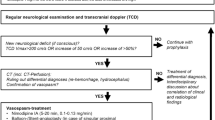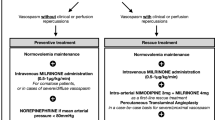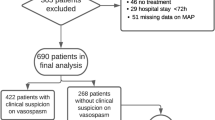Abstract
Cerebral vasospasm is the classic cause of delayed neurological deterioration after aneurysmal subarachnoid hemorrhage, leading to cerebral ischemia and infarction, and thus to poor outcome and occasionally death. Advances in diagnosis and treatment—principally the use of nimodipine, intensive care management, hemodynamic manipulations and endovascular neuroradiology procedures—have improved the prospects for these patients, but outcomes remain disappointing. Recent clinical trials have demonstrated marked prevention of vasospasm with the endothelin receptor antagonist clazosentan, yet patient outcome was not improved. This Review considers possible explanations for this result and proposes alternative causes of neurological deterioration and poor outcome after subarachnoid hemorrhage, including delayed effects of global cerebral ischemia, thromboembolism, microcirculatory dysfunction and cortical spreading depression.
Key Points
-
Delayed vasospasm of the large cerebral arteries is an important cause of cerebral ischemia and infarction after aneurysmal subarachnoid hemorrhage
-
Vasospasm causes delayed neurological deterioration as a consequence of ischemia
-
Recent clinical trials demonstrated marked prevention of vasospasm with the endothelin receptor antagonist clazosentan, yet patient outcome was not improved
-
There might be other causes for delayed neurological deterioration, including thromboembolism, microcirculatory changes, cortical spreading depression, and delayed neuronal apoptosis
This is a preview of subscription content, access via your institution
Access options
Subscribe to this journal
Receive 12 print issues and online access
$209.00 per year
only $17.42 per issue
Buy this article
- Purchase on SpringerLink
- Instant access to full article PDF
Prices may be subject to local taxes which are calculated during checkout


Similar content being viewed by others
References
Macdonald RL et al. (2007) Randomized trial of clazosentan for prevention of vasospasm after aneurysmal subarachnoid hemorrhage [abstract #462]. Stroke 38: a453–a607
9th International Conference on Cerebral Vasospasm [http://www.cerebralvasospasm9.org/wm.php]
Sudlow CL and Warlow CP (1997) Comparable studies of the incidence of stroke and its pathological types: results from an international collaboration. International Stroke Incidence Collaboration. Stroke 28: 491–499
Johnston SC et al. (1998) The burden, trends, and demographics of mortality from subarachnoid hemorrhage. Neurology 50: 1413–1418
Cushing H (1923) Contributions to the clinical study of cerebral aneurysms. Guys Hosp Rep 73: 159–163
Symonds CP (1923) Contributions to the clinical study of intracranial aneurysms. Guys Hosp Rep 73: 139–158
Hop JW et al. (1997) Case-fatality rates and functional outcome after subarachnoid hemorrhage: a systematic review. Stroke 28: 660–664
Macdonald RL et al. (2006) Prevention of cerebral vasospasm after aneurysmal subarachnoid hemorrhage with clazosentan, an endothelin receptor antagonist [abstract #800]. Neurosurgery 59: a453
Ohman J and Heiskanen O (1988) Effect of nimodipine on the outcome of patients after aneurysmal subarachnoid hemorrhage and surgery. J Neurosurg 69: 683–686
Pickard JD et al. (1989) Effect of oral nimodipine on cerebral infarction and outcome after subarachnoid haemorrhage: British aneurysm nimodipine trial. BMJ 298: 636–642
Nolan CP and Macdonald RL (2006) Can angiographic vasospasm be used as a surrogate marker in evaluating therapeutic interventions for cerebral vasospasm? Neurosurg Focus 21: E1
Sehba FA and Bederson JB (2006) Mechanisms of acute brain injury after subarachnoid hemorrhage. Neurol Res 28: 381–398
Ostrowski RP et al. (2006) Molecular mechanisms of early brain injury after subarachnoid hemorrhage. Neurol Res 28: 399–414
Yundt KD et al. (1998) Autoregulatory vasodilation of parenchymal vessels is impaired during cerebral vasospasm. J Cereb Blood Flow Metab 18: 419–424
Perkins E et al. (2002) Evaluation of the microvasculature and cerebral ischemia after experimental subarachnoid hemorrhage in dogs. J Neurosurg 97: 896–904
Stein SC et al. (2006) Thromboembolism and delayed cerebral ischemia after subarachnoid hemorrhage: an autopsy study. Neurosurgery 59: 781–787
Sehba FA et al. (2005) Acute microvascular platelet aggregation after subarachnoid hemorrhage. J Neurosurg 102: 1094–1100
Suzuki S et al. (1990) Cerebral microthrombosis in symptomatic cerebral vasospasm—a quantitative histological study in autopsy cases. Neurol Med-Chir (Tokyo) 30: 309–316
Dreier JP et al. (2006) Delayed ischaemic neurological deficits after subarachnoid haemorrhage are associated with clusters of spreading depolarizations. Brain 129: 3224–3237
Prunell GF et al. (2004) Experimental subarachnoid hemorrhage: cerebral blood flow and brain metabolism during the acute phase in three different models in the rat. Neurosurgery 54: 426–436
Siesjo BK (1992) Pathophysiology and treatment of focal cerebral ischemia: part 1: pathophysiology. J Neurosurg 77: 169–184
Sehba FA et al. (1999) Effects of S-nitrosoglutathione on acute vasoconstriction and glutamate release after subarachnoid hemorrhage. Stroke 30: 1955–1961
Prunell GF et al. (2005) Delayed cell death related to acute cerebral blood flow changes following subarachnoid hemorrhage in the rat brain. J Neurosurg 102: 1046–1054
Badaut J et al. (2003) Aquaporin 1 and aquaporin 4 expression in human brain after subarachnoid hemorrhage and in peritumoral tissue. Acta Neurochir Suppl 86: S495–S498
Park S et al. (2004) Neurovascular protection reduces early brain injury after subarachnoid hemorrhage. Stroke 35: 2412–2417
Megyesi JF et al. (2000) In vivo animal models of cerebral vasospasm: a review. Neurosurgery 46: 448–460
Sehba FA et al. (2004) Nitric oxide synthase in acute alteration of nitric oxide levels after subarachnoid hemorrhage. Neurosurgery 55: 671–677
Zausinger S et al. (2004) Hypertonic fluid resuscitation from subarachnoid hemorrhage in rats. Neurosurgery 55: 679–686
Prunell GF et al. (2003) Experimental subarachnoid hemorrhage: subarachnoid blood volume, mortality rate, neuronal death, cerebral blood flow, and perfusion pressure in three different rat models. Neurosurgery 52: 165–175
Jennett B and Bond M (1975) Assessment of outcome after severe brain damage: a practical scale. Lancet 1: 480–484
Grubb RLJ et al. (1977) Effects of subarachnoid hemorrhage on cerebral blood volume, blood flow, and oxygen utilization in humans. J Neurosurg 46: 446–453
Nagai H et al. (1976) Effect of subarachnoid haemorrhage on micro-circulation in hypothalamus and brain stem of dogs. Neurochirurgia (Stuttg) 19: 135–144
Ohkuma H et al. (1997) Morphological changes of intraparenchymal arterioles after experimental subarachnoid hemorrhage in dogs. Neurosurgery 41: 230–235
Ohkuma H et al. (1999) Antisense preproendothelin-oligoDNA therapy for vasospasm in a canine model of subarachnoid hemorrhage. J Neurosurg 90: 1105–1114
Park KW et al. (2001) Microvascular endothelial dysfunction and its mechanism in a rat model of subarachnoid hemorrhage. Anesth Analg 92: 990–996
Ohkuma H et al. (2000) Impact of cerebral microcirculatory changes on cerebral blood flow during cerebral vasospasm after aneurysmal subarachnoid hemorrhage. Stroke 31: 1621–1627
Uhl E et al. (2003) Intraoperative detection of early microvasospasm in patients with subarachnoid hemorrhage by using orthogonal polarization spectral imaging. Neurosurgery 52: 1307–1315
Bevan JA et al. (1998) Functional changes in human pial arteries (300 to 900 micrometer ID) within 48 hours of aneurysmal subarachnoid hemorrhage. Stroke 29: 2575–2579
Katusic ZS et al. (1993) Subarachnoid hemorrhage and endothelial L-arginine pathway in small brain stem arteries in dogs. Stroke 24: 392–399
Nihei H et al. (1991) Does vasospasm occur in small pial arteries and arterioles of rabbits? Stroke 22: 1419–1425
Zubkov AY et al. (2000) Morphological changes of cerebral penetrating arteries in a canine double hemorrhage model. Surg Neurol 54: 212–219
Giller CA et al. (1998) Detection of emboli after surgery for intracerebral aneurysms. Neurosurgery 42: 490–493
Griffiths PD et al. (2001) Multimodality MR imaging depiction of hemodynamic changes and cerebral ischemia in subarachnoid hemorrhage. Am J Neuroradiol 22: 1690–1697
van den Bergh WM et al. (2006) Randomized controlled trial of acetylsalicylic acid in aneurysmal subarachnoid hemorrhage: the MASH Study. Stroke 37: 2326–2330
Siironen J et al. (2003) No effect of enoxaparin on outcome of aneurysmal subarachnoid hemorrhage: a randomized, double-blind, placebo-controlled clinical trial. J Neurosurg 99: 953–959
Dreier JP et al. (2000) Products of hemolysis in the subarachnoid space inducing spreading ischemia in the cortex and focal necrosis in rats: a model for delayed ischemic neurological deficits after subarachnoid hemorrhage? J Neurosurg 93: 658–666
Dumont AS et al. (2003) Cerebral vasospasm after subarachnoid hemorrhage: putative role of inflammation. Neurosurgery 53: 123–133
Macdonald RL and Weir B (2001) Cerebral Vasospasm. San Diego: Academic Press
Nishizawa S and Laher I (2005) Signaling mechanisms in cerebral vasospasm. Trends Cardiovasc Med 15: 24–34
Reilly C et al. (2004) Clot volume and clearance rate as independent predictors of vasospasm after aneurysmal subarachnoid hemorrhage. J Neurosurg 101: 255–261
Pluta RM (2005) Delayed cerebral vasospasm and nitric oxide: review, new hypothesis, and proposed treatment. Pharmacol Ther 105: 23–56
Aihara Y et al. (2003) Effects of a nitric oxide donor on and correlation of changes in cyclic nucleotide levels with experimental vasospasm. Neurosurgery 52: 661–667
Clozel M et al. (1993) Pathophysiological role of endothelin revealed by the first orally active endothelin receptor antagonist. Nature 365: 759–761
Hansen-Schwartz J et al. (2003) Subarachnoid hemorrhage enhances endothelin receptor expression and function in rat cerebral arteries. Neurosurgery 52: 1188–1194
Jahromi BS et al. (2005) Potassium channels in experimental cerebral vasospasm. In Cerebral Vasospasm. Advances in Research and Treatment, 20–24 (Ed Macdonald RL) New York: Thieme
Cipolla MJ et al. (2001) Threshold duration of ischemia for myogenic tone in middle cerebral arteries: effect on vascular smooth muscle actin. Stroke 32: 1658–1664
Takano T et al. (2006) Astrocyte-mediated control of cerebral blood flow. Nat Neurosci 9: 260–267
Acknowledgements
This research was supported in part by the Intramural Research Program of the NIH, National Institute of Neurological Disorders and Stroke.
Author information
Authors and Affiliations
Corresponding author
Ethics declarations
Competing interests
RH Macdonald is supported by grants from the National Institutes of Health, American Heart Association and Brain Research Foundation. He is a consultant for Actelion Pharmaceuticals. JH Zhang is supported by grants from the National Institutes of Health and American Heart Association. R Pluta declared he has no competing interests.
Rights and permissions
About this article
Cite this article
Macdonald, R., Pluta, R. & Zhang, J. Cerebral vasospasm after subarachnoid hemorrhage: the emerging revolution. Nat Rev Neurol 3, 256–263 (2007). https://doi.org/10.1038/ncpneuro0490
Received:
Accepted:
Issue Date:
DOI: https://doi.org/10.1038/ncpneuro0490



